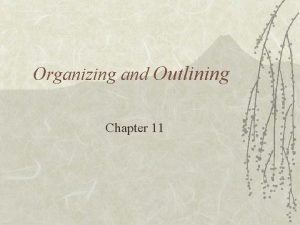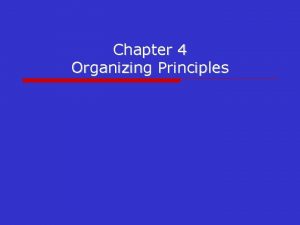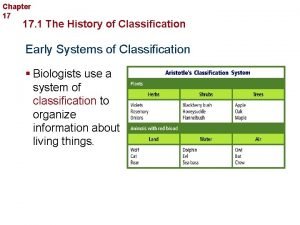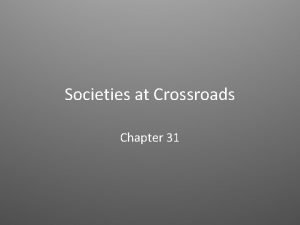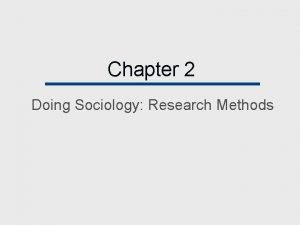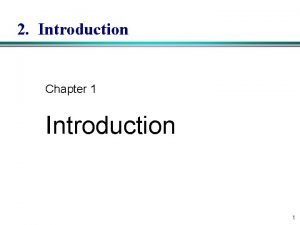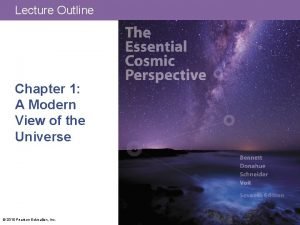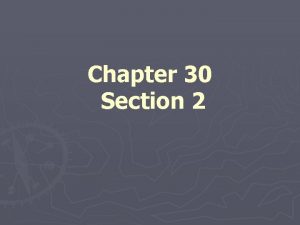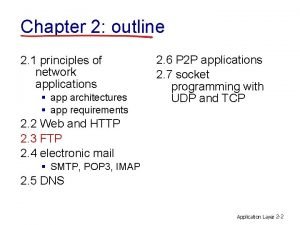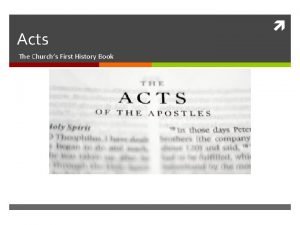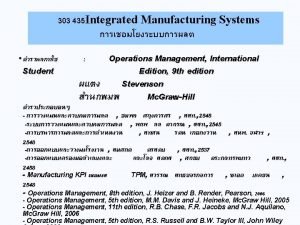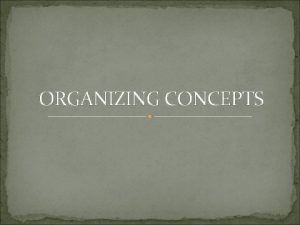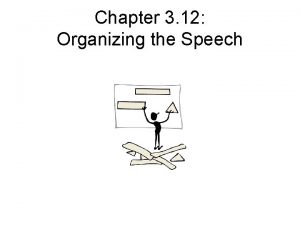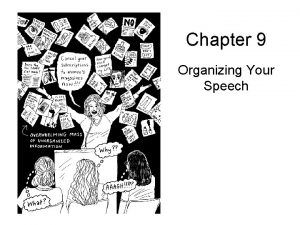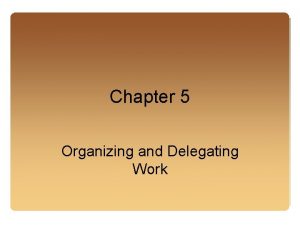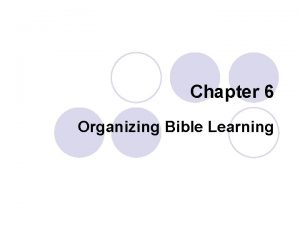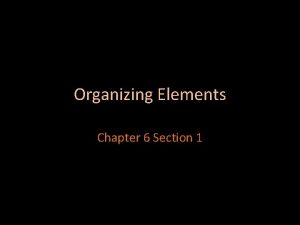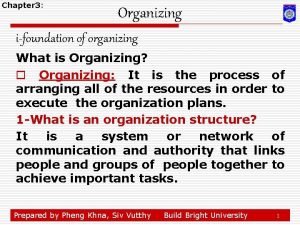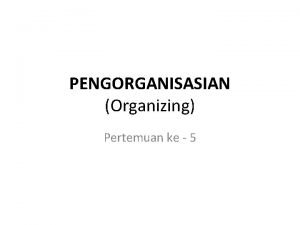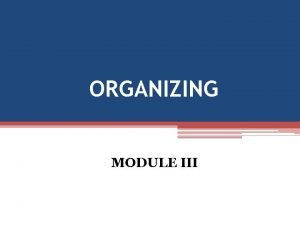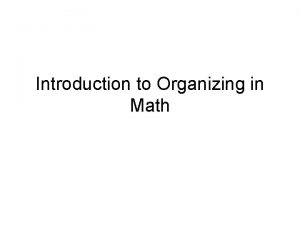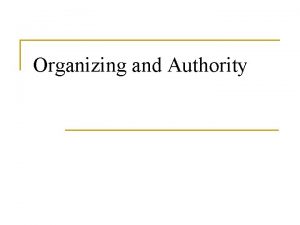Chapter 4 Organizing Principles Outline Chapter 4 Organizing






















- Slides: 22

Chapter 4 Organizing Principles

Outline Chapter 4 Organizing Principles Utilitarian Thinking Three Utilitarian Approaches o Cost/Benefit Approach o The Act Utilitarian Approach o The Rule Utilitarian Approach The Ethics of Respect of Persons Three Respect of Persons Approaches o The Golden Rule o The Self-Defeating Criterion o Rights Convergence, Divergence, and Creative Middle Ways 2

Two Key Concepts: Universalizability and Reversibility. o o Universalizability: Whatever is right (or wrong) in one situation is right (or wrong) in any relevantly similar situation. (it requires us to be consistent in our thinking) Reversibility: Treat others as you would have them treat you. What would you think if the roles were reversed? 3

Case: Engineer David Parkinson and the Solid waste dump-site in Madison County o o o David a member of the Madison County Solid Waste Management Planning Committee (SWPC) is going through the choice between two prospective landfill sites: (1) A piece of land originally proposed by the SWPC in a sparsely populated region, (2) An alternative place proposed by the ‘Fairway Coalition’ bordering the ‘ghetto’ section of the Madison City with about 8000 residents. The alternative site was proposed by a small group of wealthy and politically influential people who are planning to purchase a nearby land for development. Since the idea of a dump-site close to this newly-built luxurious neighborhood does not sound nice, they proposed this alternative place and launched a PR campaign. David can analyze this problem from two perspectives: (i) the utilitarian approach, (ii) equal respect for persons principle. 4

Case: Engineer David Parkinson and the Solid waste dump-site in Madison County o o o Based on the Utilitarian Philosophy the greatest good for the greatest number of people should be the primary concern (not for one individual). Respect for Persons should imply that people should be treated with fairness and respect for their overall well-being regardless of race, gender, socio-economic status, etc. Both approaches in this case will lead to the same conclusion (choice of the first place as the dump-site) in this example, but this is not necessarily the case for other examples. 5

Case : Benzene Exposure in the Workplace o o o The OSHA decision follows the respect for persons approach. The Supreme Court however, based the conclusion on the utilitarian thinking. Different approaches for this case yield contradicting results. 6

The Utilitarian Philosophy o o The work of John Stuart Mill and Utilitarian Thinking to maximize overall benefits, welfare, happiness, etc. of all people. Well-being and freedom. (next slide) How to measure the benefits and costs of a certain action in the utilitarian approach? In the long-run as well as in the shortrun. How to define the scope of the Audience for which the overall good should be maximized. (Audience: our country? our company? our community? ) o Is the utilitarian philosophy unfair to the discriminated or the economically deprived? (Plant discharging pollutant to river. Fish digest pollutant, people eat fish & experience health problems. Allowing discharge will save jobs, permit local community economically viable. Pollutant will affect small portion of the population who fish in the river [economically deprived] and eat fish from the river. According to the utilitarian perspective, allowing discharge of pollutant cannot be justifiable) 7

Utility o Happiness Preference Utilitarianism: we should promote these general conditions that allow each individual to pursue happiness as he or she conceives it. At least two conditions are necessary for most people to pursue happiness effectively: freedom and well-being. n n Freedom is the ability to make unforced choices in following our preferences. Well-being is the set of conditions necessary to make effective use of freedom (health, food, shelter and education) 8

Three Approaches of the Utilitarian Thinking o The Cost/Benefit Approach n n n o Assess the available options. (1) Assess the costs and benefits (converted to monetary terms) of each action for the entire audience. (2) Make the decision which would result in the greatest benefit relative to the cost. (3) Example for the C/B Appr: Pollution caused by a Chemical Plant near a residential area. n n (1) assess the options (2) measure costs/benefits of pollution costs: cost of homes near the plant vs cost of homes in locations away from pollutants, cost of loss of productivity (days missed at work, cost of medical services of poorer health benefits: providing jobs, a substantial tax base (pollution tax) n (3) compare costs/benefits of eliminating pollution 9

Three Approaches of the Utilitarian Thinking (cont. ) o Shortcomings of the Cost/Benefit Approach n n Overrides other considerations other than the economic values of costs/benefits. Difficulty in assessing monetary values for costs/benefits (for example, the value of human life). Ignores the unequal distribution of costs/benefits among different sections of the society. Cost/Benefit Approach justified many practices in the past which today appear to be morally wrong. 10

Three Approaches of the Utilitarian Thinking (cont. ) o The Act Utilitarian Approach n n n Enumerate the available options. Determine the appropriate audience for all these options. Choose the option which is likely to bring the greatest good for the audience. The universalizability should apply whatever course of action is taken. Unlike the Cost/Benefit Approach no need to quantify costs and benefits of all actions, but the idea is to still maximize the good consequences for the people. e. g. Assume the economic costs are roughly equal for two safety devices in an automotive design. Then the choice is more likely the one that reduces the most injuries and fatalities 11

Three Approaches of the Utilitarian Thinking (cont. ) o The Rule Utilitarian Approach n n Universalizability: would utility be maximized if everyone did the same thing under similar circumstances? Traffic rules for the overall utility of people: when is it justified to cross through red-light? o o n When you are in a hurry? (What if everybody does the same? ) When there is an exceptional danger or emergency? To implement the Rule Utilitarian Approach one should find out if there are well-understood, generally observed rules which serve utilitarian ends. 12

Three Approaches of the Utilitarian Thinking (cont. ) o The Rule Utilitarian Approach (cont. ) n n Karen facing the decision of unilaterally substituting cheaper parts instead of those specified in the contract from a Rule Utilitarian standpoint. What could be the typical relevant rules o o n n Rule 1. Engineers may unilaterally substitute cheaper parts for those specified in the contract. Rule 2. Engineers may not unilaterally substitute cheaper parts for those specified in the contract. Who is the audience and which rules come close to represent the overall expectations of the audience. The rule utilitarian judges the conformation of the actions to certain applicable rules. That is, if she decides (as surely will) on Rule 2, then she should follow this rule in her own action and not substitute the cheaper parts. 13

The Respect for Persons Philosophy o Unlike the Utilitarian Thinking priority is given to fulfill the ultimate respect for individuals. Maximizing the welfare of the majority should come after this. n o Suppose that there is a socio-political survey indicating that the capital punishment significantly reduces the crime rate in the society. From a utilitarian perspective one could argue that capital punishment will be justifiable. Most possibly it won’t be justifiable from the side of respect for persons. There are two difficulties of resolving ethical problems using this approach: 14

The Respect for Persons Philosophy (cont. ) o Sometimes it will lead the decision maker to a deadlocking situation. n n o Harry realizes that he cannot fulfill the due date of a certain product order has two options: (1) Extend the due date of the shipment, (2) Deliver a batch of low quality products on time. What should he do? Whatever option he chooses he breaks the principle of respect for persons. It is very possible for this approach to yield unreasonable and unrealistic solutions when compared to the utilitarian way of thinking. 15

Three Approaches of the Respect for Persons o The Golden Rule n n n o The idea based on the reversibility principle. “Always treat other people in the way you expect them to treat you. ” “Do not do to others what you would not want them to do to you. ” (due to Confucius) How to implement the Golden Rule. n n n Analyze the situation and find out all possible actions. Determine the consequences of all these actions. Place yourself in the shoes of those who will be affected by the consequences of each alternative action and ask the question: “Would I be willing to accept those consequences? ” 16

Three Approaches of the Respect for Persons (cont. ) o The Golden Rule (cont. ) n n The manager orders a young engineer to conceal the fact that the emission from a production plant might cause minor health problems for some residents. Based on the Golden Rule principle what should be his reasoning to justify the acceptability of his action? o o n n “Would I—as an engineer working in the plant—be willing to get a similar order from my boss? ” “Would I—as a resident living nearby—be willing to exposed to the minor risk caused by the plant? ” Problems could arise with the priority of conflicting values (moral obligations to the boss vs. the public). The differing moral values and the beliefs of the audience might lead to different conclusions. 17

Three Approaches of the Respect for Persons (cont. ) o The Self-Defeating Criterion n n o o Alternative application of the universalizability. “Would I be able to perform this action if everyone did perform it under similar circumstances? ” Analyze the situation and find out available options. Determine the consequences of these options. Determine whether the options are self-defeating if adopted by everyone else under same circumstances. No reference to moral values of the agent (the decision maker) or the recipient (audience). “Is the action self-defeating if the practice is adopted universally? ” 18

Three Approaches of the Respect for Persons (cont. ) o Rights n n o A right is an entitlement to act or have another individual act in a certain way. Rights serve as a protective barrier or shield against others infringing their moral agency, freedom, etc. One could argue right to food, education, housing but the focus will be on immunity against interference from others to exercise basic freedoms. From this perspective the rights of individuals require corresponding duties of non-interference. Complications might occur. 19

Three Approaches of the Respect for Persons (cont. ) o The Rights of People is a controversial issue. n o General principle that an individual should not be deprived of certain basic needs. Conflicting Rights n n A plant manager saves money with a new action which emits a pollutant to the atmosphere. He has a right of free action (on behalf of his firm), but the pollutant threatens the right of residents to live in a healthy neighborhood. A priority of rights is useful. Gewirth suggests a hierarchy of rights from the most basic to less basic. o o o Level 1: life, physical integrity, mental well-being. Level 2: right to be informed, not deceived, etc. Level 3: right to prosper, acquire property, etc. 20

Three Approaches of the Respect for Persons (cont. ) o How to apply the Rights Perspective to evaluation of general moral rules as well as the evaluation of particular cases. n n n Identify the basic obligations, values, interests and note down the conflicts. Analyze the action to determine available options and rights which are at stake. Determine the audience of the action. Evaluate the seriousness of the infringements of rights considering the levels of rights and the number of violations. Choose the course of action generating the least serious infringement of rights. 21

Convergence, Divergence, or Creative Middle Way Solutions o o o Convergence: if Utilitarian and Respect for Persons lead to the same conclusion. Divergence: if they lead to conflicting results. Is it possible to combine the concerns of Utilitarian and Respect for Persons to reach to creative middle way solutions. n n Using dead bodies in automobile crash tests. Obvious benefit to society since the use of dummies would not be helpful (utilitarian thinking). Seriously questionable (respect for persons). Middle way solution: prior consent of the deceased person and the informed consent of the family. 22
 Organizing an outline
Organizing an outline Organizing principles
Organizing principles Quote sandwich examples
Quote sandwich examples Chapter 2 worksheet organizing and administering
Chapter 2 worksheet organizing and administering Organizing life's diversity
Organizing life's diversity Labeling theory of deviance examples
Labeling theory of deviance examples Romans outline by chapter
Romans outline by chapter Research proposal
Research proposal Chapter 27 give me liberty
Chapter 27 give me liberty Secondary data
Secondary data Chapter 38 a world without borders outline
Chapter 38 a world without borders outline 24 chapter outline
24 chapter outline Hunger games chapter 10
Hunger games chapter 10 Chapter 31 societies at crossroads
Chapter 31 societies at crossroads Ap world history chapter 28 outline
Ap world history chapter 28 outline Advantages and disadvantages of observation method
Advantages and disadvantages of observation method Chapter 1 outline
Chapter 1 outline Chapter 1 outline
Chapter 1 outline Agent orange and napalm
Agent orange and napalm Chapter 2 outline
Chapter 2 outline Book of acts outline
Book of acts outline 24 chapter outline
24 chapter outline 24 chapter outline
24 chapter outline
